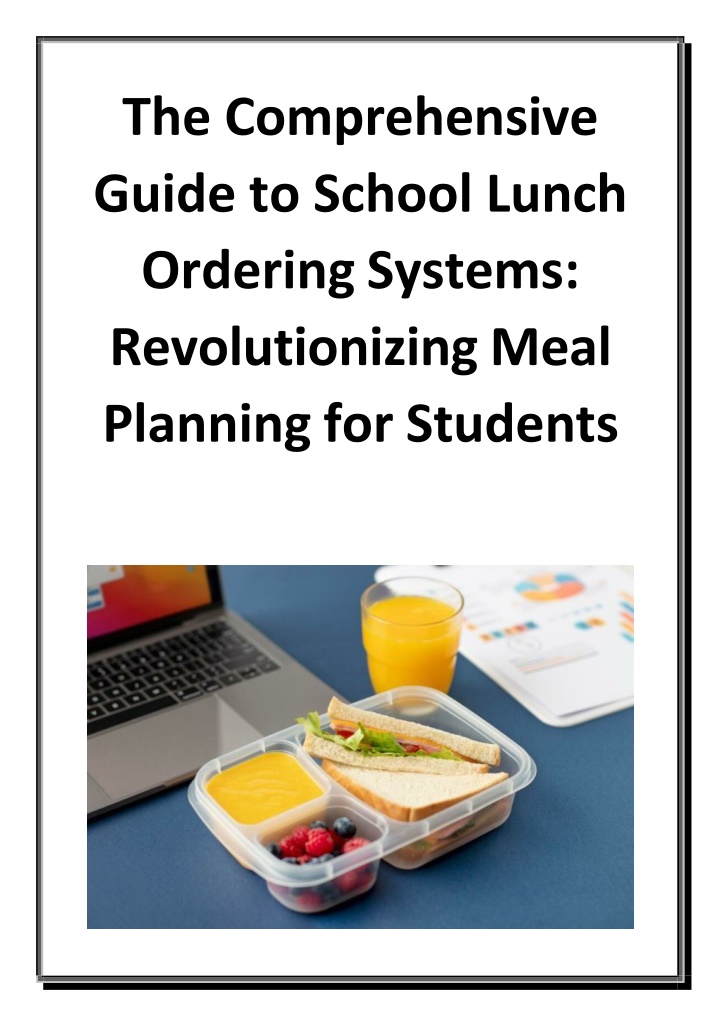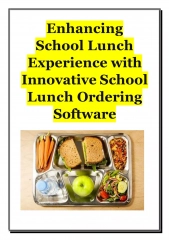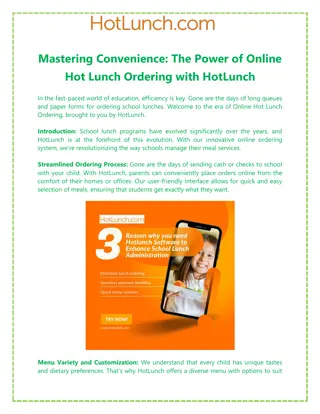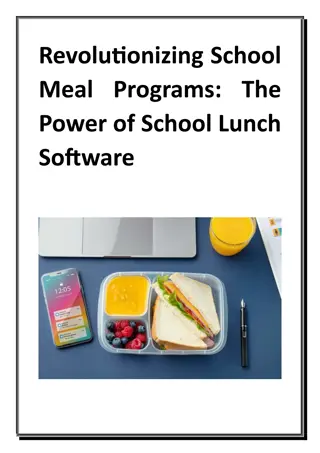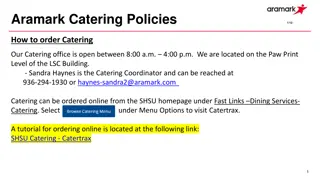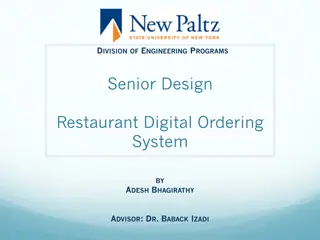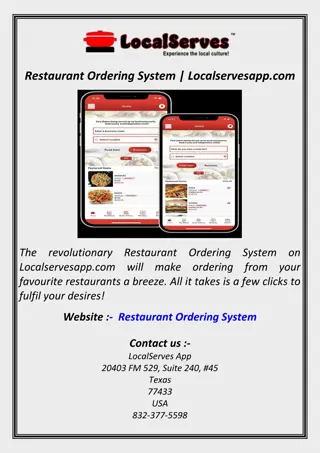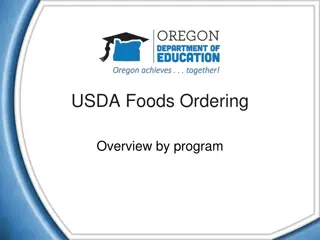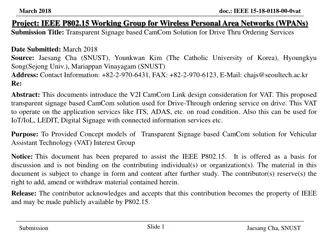The Comprehensive Guide to School Lunch Ordering Systems
In the modern era of technology, the way we manage daily tasks has significantly evolved. One such area that has seen a transformative change is school lunch programs. With the introduction of school lunch ordering systems, the process of planning, p
Uploaded on Jul 23, 2024 | 7 Views
Download Presentation

Please find below an Image/Link to download the presentation.
The content on the website is provided AS IS for your information and personal use only. It may not be sold, licensed, or shared on other websites without obtaining consent from the author.If you encounter any issues during the download, it is possible that the publisher has removed the file from their server.
You are allowed to download the files provided on this website for personal or commercial use, subject to the condition that they are used lawfully. All files are the property of their respective owners.
The content on the website is provided AS IS for your information and personal use only. It may not be sold, licensed, or shared on other websites without obtaining consent from the author.
E N D
Presentation Transcript
The Comprehensive Guide to School Lunch Ordering Systems: Revolutionizing Meal Planning for Students
Introduction In the modern era of technology, the way we manage daily tasks has significantly evolved. One such area that has seen a transformative change is school lunch programs. With the introduction of school lunch ordering systems, the process of planning, preparing, and distributing meals to students has become more efficient and streamlined. This blog delves into the benefits, features, and implementation of school lunch ordering systems, highlighting how they are revolutionizing meal planning in educational institutions. The Evolution of School Lunch Programs Traditionally, school lunch programs involved a lot of manual effort, from menu planning to meal preparation and distribution. This often led to challenges such as food waste, long lunch lines, and inconsistent meal quality. The advent of school lunch ordering systems has addressed many of these issues, providing a more organized and efficient approach to school meal management. What is a School Lunch Ordering System? A school lunch ordering system is a digital platform that allows parents, students, and school administrators to manage lunch orders online. These systems typically include features such as menu planning, online ordering, payment processing, and real-time updates. By leveraging technology, schools can offer a more convenient and customizable lunch experience for students. Benefits of a School Lunch Ordering System 1. Convenience for Parents and Students One of the primary benefits of a school lunch ordering system is the convenience it offers. Parents can easily log into the platform, view the menu, and place orders for their children from the comfort of their homes. This eliminates the need for daily lunch preparation and ensures that students receive a nutritious meal every day.
2. Reduced Food Waste With pre-ordering, schools can accurately estimate the number of meals required each day, significantly reducing food waste. This not only helps in managing resources better but also promotes environmental sustainability. 3. Improved Nutritional Quality School lunch ordering systems often collaborate with nutritionists to create balanced and healthy menus. Parents can review the nutritional content of each meal, ensuring that their children are consuming nutritious food that supports their growth and development. 4. Customization and Dietary Accommodations These systems allow for menu customization, accommodating various dietary needs and preferences. Whether a student is vegetarian, gluten-free, or has specific allergies, school lunch ordering systems can cater to these requirements, ensuring that every child has access to a safe and satisfying meal. 5. Streamlined Administration For school administrators, managing lunch programs becomes much simpler with a digital ordering system. It automates tasks such as order collection, payment processing, and inventory management, freeing up time for other important administrative duties. Key Features of an Effective School Lunch Ordering System 1. User-Friendly Interface A good school lunch ordering system should have an intuitive and easy-to- navigate interface. This ensures that parents and students can place orders without any hassle. 2. Flexible Menu Options The system should offer a variety of menu options, allowing users to select meals that meet their dietary needs and preferences. It should also provide detailed nutritional information for each menu item.
3. Secure Payment Processing Security is crucial when handling online payments. A reliable school lunch ordering system should have secure payment gateways to protect users' financial information. 4. Real-Time Updates Real-time updates on order status, menu changes, and important announcements are essential features of an effective system. This keeps parents and students informed and helps in managing expectations. 5. Mobile Accessibility With the increasing use of smartphones, having a mobile-friendly platform or dedicated app can enhance user convenience. Parents can place orders and make payments on the go, making the system more accessible. Implementing a School Lunch Ordering System 1. Assessing Needs and Goals Before implementing a school lunch ordering system, it's important to assess the specific needs and goals of the school. This includes understanding the dietary preferences of students, budget constraints, and the desired level of customization. 2. Choosing the Right Platform There are various school lunch ordering platforms available in the market, each with its own set of features and benefits. Schools should choose a platform that aligns with their needs and budget. It's also helpful to read reviews and seek recommendations from other schools. 3. Training and Support Proper training is essential for the successful implementation of a school lunch ordering system. Schools should provide training sessions for staff, parents, and students to ensure everyone is comfortable using the platform. Additionally, having ongoing technical support can help address any issues that may arise.
4. Promoting the System Once the system is in place, schools should promote it to parents and students. This can be done through newsletters, social media, and school websites. Clear communication about the benefits and how to use the system will encourage more users to adopt it. 5. Monitoring and Evaluation After implementation, it's important to continuously monitor and evaluate the system's performance. Collecting feedback from parents, students, and staff can provide valuable insights into areas of improvement. Regularly updating the system based on this feedback will ensure it continues to meet the needs of the school community. Case Study: Success Stories Many schools have successfully implemented school lunch ordering systems and experienced significant benefits. For example, XYZ School reported a 30% reduction in food waste and increased student satisfaction with meal options. By partnering with a reputable lunch ordering platform, they were able to offer a diverse menu that catered to various dietary needs. Conclusion A school lunch ordering system is a powerful tool that can transform the way schools manage their meal programs. From providing convenience and customization to reducing food waste and improving nutritional quality, the benefits are manifold. By choosing the right platform, providing proper training, and continuously evaluating the system's performance, schools can ensure a successful implementation that meets the needs of their community. Embrace the future of school lunch programs with a digital ordering system and make meal planning a seamless and enjoyable experience for everyone involved.
